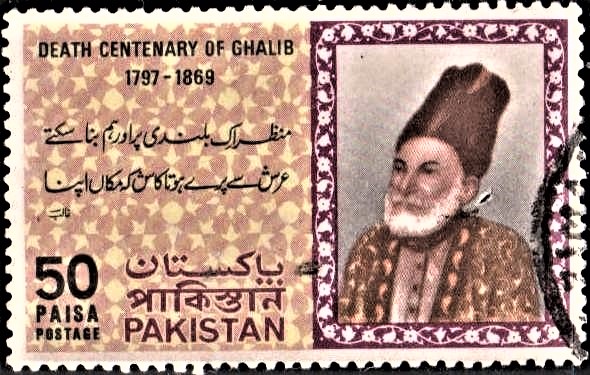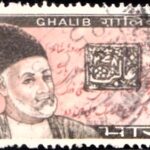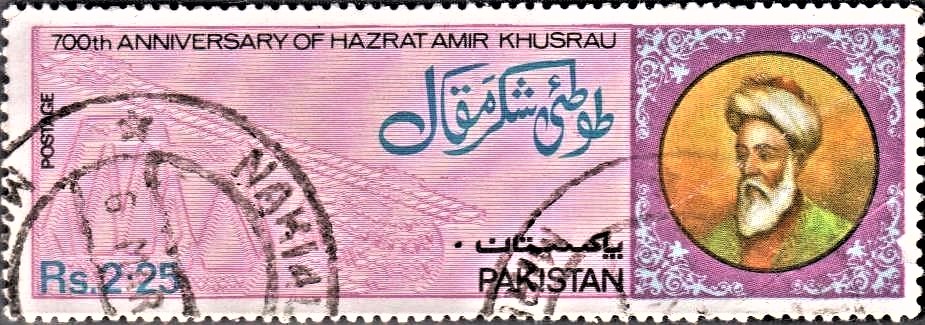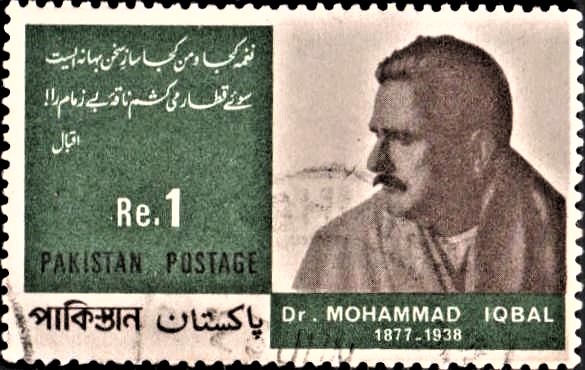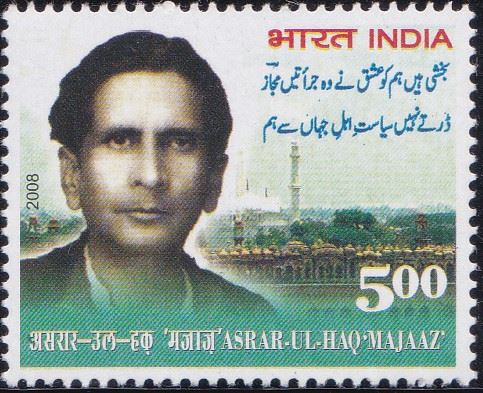
Asrar-ul-Haq ‘Majaaz’
A commemorative postage stamp on Majaz Lakhnawi, an Indian Urdu poet :
 Issued by India
Issued by India
Issued on Mar 28, 2008
Issued for : The Department of Posts is pleased to release a commemorative postage stamp on Asrar-ul-Haq-‘Majaaz’.
Credits :
Stamp & FDC : Brahm Prakash
Cancellation : Alka Sharma
Type : Stamp, Mint Condition
Colour : Multi colour
Denomination : 500 Paise
Stamps Printed : 0.4 Million
Printing Process : Wet–Offset
Printer : Security Printing Press, Hyderabad
Name : Asrar ul Haq Majaz
Born on Oct 19, 1911 at Rudauli, Bara Banki district, Uttar Pradesh, India
Died on Dec 5, 1955 at Lucknow, Uttar Pradesh, India
About :
- If the history of Urdu Literature is conceived in terms of intensity of feelings and a natural melancholic spontaneity of thought, the name of Majaaz Lucknavi would seem to epitomize this paradigm. Just as Keats imbued English literature with a new poetic sensibility, Majaaz Rudauli a new fierce intensity of emotions to Urdu poetry. His poetry is effortless in which there is neither any laborious artistry nor contrived sophistication. Rhythm came as natural to him as breathing. He sang of love and revolution in the same breath. He dreamt of a new social order where the strong are just and the weak secure. He had the romantic madness of a Spinoza and can be seen as an early precursor of Firaq Gorakhpuri, the legendary Urdu poet.
- Born at Rudauli in Bara Banki district of modern Uttar Pradesh on 19th October, 1911, Majaaz whose real name was Asrar-ul-Haq, was educated at Lucknow, Agra and Aligarh from where he graduated in 1936 from Aligarh Muslim University. Later he wrote the university anthem entitled “Yeh Mera Chaman” (This is my Garden) which is still sung at university convocations and other solemn occasions.
- Jo Abr Yahan sey Uthega
Vo Saare Jahan par barsega
(This winds that arise from this campus will bring rain in the whole world) - At 25, Majaaz was drawn towards the Progressive Writers’ Movement which was the rallying center of liberals and intellectuals, and the impetus it gave to literature was remarkable. Started by Sajjad Zaheer and Mulk Raj Anand, among others, it swept the whole country in all major Indian languages. The literary movement was a major ideological turning point in its attempt to liberate poetic diction and content from feudalistic cliches. Majaaz lost no time to become its founding member and attended its first conference at Lucknow presided over by Premchand. The movement attracted the best minds of the time such as Faiz, Firaq, Manto, Krishan Chander and Bedi. It was this upsurge which made Majaaz change from the traditional ‘Ghazal‘ to the modern ‘Nazm‘. It suited his genius and the temper of the times.
- Majaaz wrote sparingly. His poetic output is frugal but whatever little he has left deserves to be bound in pure gold. His small collection consists of ‘Ahang‘ (1938) which was re-printed several times under different names such as ‘Shab–e–Tab‘ (1945) and ‘Saz-i-Naau’ with marginal additions. Bacchic to the core, he tried to free Urdu verse from the bondage of ‘Jaam‘ and ‘Saki‘ (The Cup and the Cup-bearer) on the one hand and from the hide-bound rules and conventions of monotonous meters on the other. He shot into prominence with his ‘Nazm’, ‘Awara‘, one of the best in Urdu poetry, included in ‘Ahang‘ – a rare combination of melody and resilience in the life of the restless youth. The classic refrain of the poem is :
- Aye Gham-e-dil kya karoon
Aye Wahshat-e-dil kya karoon
Shehar ki sarkon pai mai Naashad-o-Naakara Phiron
Jagamagatti Jagti Sarkon pai Awara Phiron
Aye Gham-e-dil kya karoon/Aye Wahshat-e-dil kya karoon
Ye Rupeli Chaon Yeh Akash par taroon ka jaal
Jaise Sufi ka Tassawar Jaise Ashiq ka Khyal
Ah lekin Kaun Jaane Kaun Samjhe Ji ka haal
Aye Gham-e-dil kya karoon/Aye Wahshat-e-dil kya karoon(On the city’s highways I wander sad and woebegone
on the glittering and lively streets I wander like
a vagabond in a stranger’s land knocking from
door-to-door. How long?
What shall I do, my sorrowing heart, my wild heart
This silvery shadow, the galaxy of stars in the sky
Like the mind of the mystic, like the insight of a lover
But who will understand my turmoil within
Ah, what shall I do, my tormented heart,
What shall I do, my sorrowful heart.)A moving poem where the poet has inter-woven his deepest anguish on the times he lived in with a lyrical poetic outburst which is unmatched.
- Aye Gham-e-dil kya karoon
- His restless mind, however, outgrew even the progressives. Persuaded by friends he joined the All India Radio where he started the radio magazine called ‘Awaz‘. He was in the company of other illustrious writers like Nirad C. Chaudhuri and Upendranath Ashk. This too did not last long, as his intense melancholic restlessness resulted in serious nervous breakdowns and mental agony. His persona and poetry both epitomized the classical melancholic hero-poet, at odds with the world and himself. Ali Sardar Jafri was to later recreate the life of Majaaz in his popular tele-serial “Kahkashan” in 1990, on the life and times of famous Urdu poets.
- “Urdu literature’s vagabond genius“, as Saeed Naqvi once called him, Majaaz died, as he lived, in a tavern in Lucknow, in utter penury and as a wanderer.
- Text : Pranav Khullar (with Contributions from Prof. Sharib Rudaulvi).


